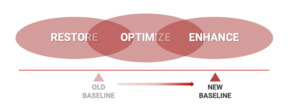Sports physical therapy spans a wide spectrum, from injury and post-operative rehabilitation to performance enhancement and injury prevention. To truly help people get the most out of their bodies, we need to focus on all three. But many of us don’t, and if you’re one of them, I think you may be really missing the boat.
There may be two main paradigms holding us back:
-
We spend the majority of time focusing on “function” and not “performance.”
-
The vast majority of the physical therapy profession is focused on injury rehabilitation, this includes both entry level curricula and most workplace settings, which limits our potential to help people maximize their function and performance.
Perhaps this is just semantics or terminology, but I know when I was in school and early in my career, “function” was indicative of people’s activities of daily living, and “performance” was related to the realm of sports. Would you agree? That was my early perception, at least. Now, I couldn’t disagree with these definitions more. Here is how I would define them now:
-
Function is an activity. Sure, this could include things like bathing and getting dressed, but I would also say running, jumping, throwing, and just playing a sport, in general, is also a function.
-
Performance is how well you perform that function.
Performance is not something that only athletes do. We all need to perform at whatever function we want with our bodies. This is probably the most important concept to understand during the rehabilitation process and one that I have continued to promote.
The Need for a Shift Towards Performance Physical Therapy
Here’s what I suspect is the typical vision of the performance spectrum to most physical therapists. At any point in time, you have your baseline. Most people then focus on either restoring or enhancing performance based on that baseline.
Often, therapists sit back and wait for someone to get injured, then help them restore themselves back to baseline. What if their baseline was part of the reason why they got injured in the first place? What if sports physical therapists were to focus more on prevention?
If we just focus on restoring their function back to their baseline, we’re completely missing the boat on helping them optimize and enhance their performance. I can’t help but think that this is one of the reasons why so many people have recurring injuries, chronic pain, and failed surgeries. Restoring people back to their baseline isn’t enough, we need to build their capacity and enhance their baseline.
As we all know, many things can predispose a person to injury, including weakness, mobility concerns, and imbalances. There has been a recent uptick in criticism on social media that too many physical therapy interventions are either ineffective, transient in nature, or both. Rightfully so. But maybe it’s not the physical therapy treatments that are the concern, but rather the overall strategy? Maybe we are focusing too much on just restoring function, and not enough on optimizing and enhancing performance?
The Goal of Performance Physical Therapy
The goal of performance physical therapy is to raise the capacity of the body, not just restore an individual to baseline function. It’s not enough to simply try to restore someone to their previous baseline. That’s “traditional” physical therapy as compared to sports physical therapy. The sports physical therapist not only restores function, but also works on optimizing and enhancing performance. That’s the key difference to me. If you add optimizing performance to the spectrum, it could look like Figure 2.
But I still don’t think that’s enough, we, as sports physical therapists can do better. If you are working on restoring or enhancing performance, you should also be working on optimizing performance. Realistically, there is an overlap between these concepts.
This changes our focus in a couple of ways:
-
It shows that these concepts all overlap. We can restore and optimize performance, and we can optimize and enhance their performance. Thinking of them as independent factors, is not ideal
-
It shifts our thought process from retrospective, to prospective. When you know the endpoint isn’t just to simply restore their baseline, but also to optimize and hopefully even enhance their performance, it changes your entire outlook on the injury rehabilitation process from day 1.
Our Profession Needs Performance as a Part of Sports Physical Therapy
I have good news for you. Physical therapists are really good at diagnosis and treating injuries. All of the assessment and diagnostic skills that allow physical therapists to evaluate and treat an injury can easily be adapted to also assess someone’s function and level of performance. Think about it, what’s the difference between an evaluation of someone with an injury and someone that is healthy that wants to enhance their performance? Special tests. That’s kinda it, right?
Special tests were designed to help diagnose a specific injury. If this special test, or cluster of tests, is positive, then you may have this injury. But everything else other than special tests essentially evaluate someone’s level of function, right? Strength, mobility, balance, movement. These are all things that we can evaluate to help develop a complete performance therapy and training program for a person. We can then work on optimizing and enhancing each of those qualities.
How do you blend all this together? Treat the injury and optimize the body. All it takes is a shift in your perspective.





